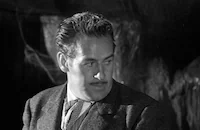Night Train to Memphis
Cast & Crew
Lesley Selander
Roy Acuff
Allan Lane
Adele Mara
Irving Bacon
Joseph Crehan
Film Details
Technical Specs

Synopsis
On a train heading into the small mountain town of Tranquility, Danny Acuff kisses a beautiful woman before hopping off a still-moving car. At the Tranquility station, the woman, whose name is Constance Stevenson, her father and their lawyer, Wilson, detrain and introduce themselves as the Smiths, claiming that they are in town to fish in the lake. Station master Roy Acuff, who does not see his brother Danny sneak into town, is also enthralled by Constance. Immediately afterward, Stevenson reminds Wilson not to reveal that he is really the president of the railroad, and is actually in town to buy up the land around the lake in order to lay tracks through it, a plan which will desiccate area farms. At home, Roy brings Mom Acuff a birthday cake and she wishes that Danny were there, after his three years in jail for robbery. Just then, Danny slips into his seat and a warm family reunion ensues until Danny realizes that Roy works for the very railroad that Danny blames for framing him. Danny storms out and stays with moonshining brothers Chad and Asa Morgan, unaware that they actually performed the robbery for which he was framed. The next day, Roy visits Danny, who saves him during a fight with Chad, but is still cold toward his brother until Roy announces that he has quit the railroad and wants to start a farm with Danny. Later on the farm, Roy is stunned by the sight of Constance fishing on a rock in the lake. When she falls into the water and hits her head, he rescues her just as Danny comes by, so he hands her to Danny and runs for the doctor. By the time he returns, everyone assumes Danny is the hero, and though Roy is upset at first he allows the misunderstanding to continue when Danny tells him that he and Constance are in love. The next night at a square dance, Stevenson offers to buy everyone's share of the lake land, supposedly for "the timber." After the party, Stevenson catches Constance with Danny and reprimands her for dating beneath her class, and within hours the Stevensons are gone. A few days later, a heartbroken Danny receives a letter from Constance in which she states that she is returning to tell him something, just as Rainbow, their family friend and local train inspector, announces that the Stevensons are really railroaders after the farmers' land. Against Roy's advice, an angry Danny agrees to see Constance, but when he does, he pretends to defend her against Chad, causing her to shoot at Chad, who then fakes his death. Danny then blackmails Stevenson for the property rights in exchange for his silence about "the murder," not realizing that Constance has mentally collapsed from guilt. Stevenson gives back the land rights but Roy forces Danny to tell the truth, at which point they realize how sick Constance is. They run to get Chad to show him to Constance, and when they arrive at his place, he is fighting with Asa. When Asa pulls out his gun, Danny recognizes it as the weapon from the robbery for which he was jailed, and realizes who his true enemy is. After a chase into the hills, Asa shoots and kills Chad, and everyone agrees to tell Constance he has been hit by a train. This shocks her out of her depression, and though Roy returns the land grants to Stevenson, the thankful father tears them up.

Director
Lesley Selander
Cast
Roy Acuff
Allan Lane

Adele Mara

Irving Bacon

Joseph Crehan
Emma Dunn

Roy Barcroft
Kenne Duncan
Leroy Mason
Nicodemus Stewart

Nina Mae Mckinney
Francis Mcdonald
Joel Friedkin
Jack O'shea
Tom London
Jack Kirk
Crew
Roy Acuff
Victor Appel
William Bradford
Owen Bradley
Dale Butts
Thomas A. Carman
Mel Foree
Marvin Hughes
Howard Lydecker
Theodore Lydecker
Bob Mark
Tony Martinelli
John Mccarthy Jr.
Dorrell Mcgowan
Dorrell Mcgowan
Stuart Mcgowan
Stuart Mcgowan
Odell Mcleod
George Milo
Joseph Novak
Adele Palmer
Lewis Physioc
Fred A. Ritter
Fred Rose
Gordon Schaefer
Morton Scott
Beasley Smith
John Stransky Jr.
Don Verk
Howard Wilson

Film Details
Technical Specs

Quotes
Trivia
Notes
A Hollywood Reporter news item from October 1945 states that the film was purchased as a vehicle for radio comic Al Pearce, but he did not appear in the final film. According to an August 1945 Hollywood Reporter item, Phil Ford was signed first to direct the picture.












